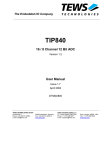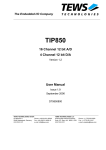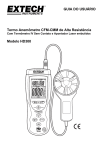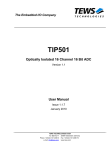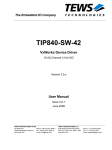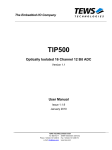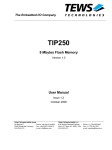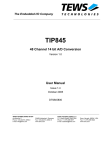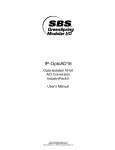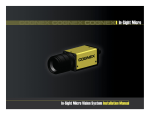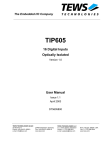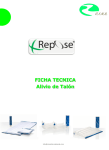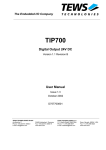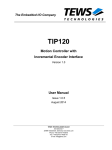Download TIP840-DOC - TEWS Bentech Taiwan
Transcript
The Embedded I/O Company TIP840 16 / 8 Channel 12 Bit ADC Version 1.2 User Manual Issue 1.2.10 March 2009 D75840800 TEWS TECHNOLOGIES GmbH Am Bahnhof 7 Phone: +49-(0)4101-4058-0 25469 Halstenbek, Germany Fax: +49-(0)4101-4058-19 www.tews.com e-mail: [email protected] TEWS TECHNOLOGIES LLC 9190 Double Diamond Parkway, Suite 127, Reno, NV 89521, USA www.tews.com Phone: +1 (775) 850 5830 Fax: +1 (775) 201 0347 e-mail: [email protected] TIP840-10 8 single-ended channel 12 bit ADC (gain 1, 10, 100) TIP840-11 8 single-ended channel 12 bit ADC (gain 1, 2, 4, 8) TIP840-20 16 single-ended / 8 differential channel 12 bit ADC (gain 1, 10, 100) TIP840-21 16 single-ended / 8 differential channel 12 bit ADC (gain 1, 2, 4, 8) This document contains information, which is proprietary to TEWS TECHNOLOGIES GmbH. Any reproduction without written permission is forbidden. TEWS TECHNOLOGIES GmbH has made any effort to ensure that this manual is accurate and complete. However TEWS TECHNOLOGIES GmbH reserves the right to change the product described in this document at any time without notice. TEWS TECHNOLOGIES GmbH is not liable for any damage arising out of the application or use of the device described herein. Style Conventions Hexadecimal characters are specified with prefix 0x, i.e. 0x029E (that means hexadecimal value 029E). For signals on hardware products, an ‘Active Low’ is represented by the signal name with # following, i.e. IP_RESET#. Access terms are described as: W Write Only R Read Only R/W Read/Write R/C Read/Clear R/S Read/Set ©1994-2009 by TEWS TECHNOLOGIES GmbH All trademarks mentioned are property of their respective owners. TIP840 User Manual Issue 1.2.10 Page 2 of 16 Issue Description Date 1.0 First Issue June 1994 1.1 Change of settling time December 1994 1.2 Change of settling time February 1996 1.3 General Revision April 2003 1.4 Addition “Technical Specification” April 2003 1.5 Correction Offset I/O Addressing October 2003 1.6 New Hardware Version 1.2 November 2003 1.7 Addition “Technical Specification” April 2004 1.8 Added Programming Note and Installation Note October 2004 1.9 New address TEWS LLC September 2006 1.2.10 New notation of User Manual Issue March 2009 TIP840 User Manual Issue 1.2.10 Page 3 of 16 Table of Contents 1 2 3 PRODUCT DESCRIPTION ......................................................................................... 6 TECHNICAL SPECIFICATION................................................................................... 7 FUNCTIONAL DESCRIPTION ................................................................................... 8 3.1 Data Correction ...............................................................................................................................8 4 5 ID ROM CONTENT..................................................................................................... 9 IP ADDRESSING...................................................................................................... 10 5.1 5.2 5.3 5.4 5.5 6 I/O Addressing...............................................................................................................................10 ADC Control and Status Register................................................................................................10 ADC Convert Register ..................................................................................................................11 ADC Data Register ........................................................................................................................12 Interrupt Vector Register..............................................................................................................12 PIN ASSIGNMENT – I/O CONNECTOR .................................................................. 13 6.1 Analog Input Connections ...........................................................................................................13 6.2 Miscellaneous Output Connections............................................................................................14 7 8 PROGRAMMING NOTES......................................................................................... 15 INSTALLATION NOTES .......................................................................................... 16 TIP840 User Manual Issue 1.2.10 Page 4 of 16 List of Figures FIGURE 1-1 : BLOCK DIAGRAM......................................................................................................................6 List of Tables TABLE 2-1 : TECHNICAL SPECIFICATION.....................................................................................................7 TABLE 4-1 : ID ROM CONTENT ......................................................................................................................9 TABLE 5-1 : REGISTER SET..........................................................................................................................10 TABLE 5-2 : ADC CONTROL AND STATUS REGISTER ..............................................................................11 TABLE 5-3 : ADC CONVERT REGISTER ......................................................................................................11 TABLE 5-4 : ADC DATA REGISTER ..............................................................................................................12 TABLE 5-5 : ADC DATA CODING ..................................................................................................................12 TABLE 5-6 : INTERRUPT VECTOR REGISTER............................................................................................12 TABLE 6-1 : ANALOG INPUT CONNECTIONS .............................................................................................13 TABLE 6-2 : MISCELLANEOUS OUTPUT CONNECTIONS..........................................................................14 TIP840 User Manual Issue 1.2.10 Page 5 of 16 1 Product Description The TIP840 is an IndustryPack® compatible module and provides 8 (16) single-ended channels of 12 bit A/D conversion. The data acquisition and conversion time is up to 10µs without channel / gain change and up to 62µs with channel / gain change. The input multiplexer offers analog overvoltage protection of up to 70Vpp. A programmable gain amplifier allows gains of 1, 10, 100 or 1, 2, 4, 8. The full-scale input range is +/-10V. An interrupt can be generated at end-of-conversion supporting an 8 bit vector. Each TIP840 is factory calibrated. The calibration information is stored in the Identification-ROM unique to each IP. Figure 1-1 : Block Diagram TIP840 User Manual Issue 1.2.10 Page 6 of 16 2 Technical Specification IP Interface Interface Single Size IndustryPack® Logic Interface compliant to ANSI/VITA 4-1995 ID ROM Data Format I I/O Space Used with no wait states Memory Space Not used Interrupts INTREQ0# used by A/D conversion DMA Not supported Clock Rate 8 MHz Module Type Type I I/O Interface Analog Inputs TIP840-20/-21: 16 single-ended channels or 8 differential channels TIP840-10/-11: 8 single-ended channels Input Gain Amplifier TIP840-10/-20: programmable for gain 1, 10, 100 TIP840-11/-21: programmable for gain 1, 2, 4, 8 Input Voltage Range for TIP840-10/-20 : ±10V (gain = 1) ±1V (gain = 10) ±0.1V (gain = 100) for TIP840-11/-21: ±10V (gain = 1) ±5V (gain = 2) ±2.5V (gain = 4) ±1.25V (gain = 8) Note: The module accuracy is guarantied at the ±10V input voltage range only for voltage range of ±9.6V. Input Overvoltage Protection up to 70Vpp Input ADC 12 bit, 10µs sampling time (ADS7804) Input Path Settling Time 52µs appr. Calibration Data Gain and offset correction values stored in ID ROM space Wait States ID ROM: No wait states Interface Connector 50-conductor flat cable Physical Data Power Requirements 180mA typical @ +5V DC 10mA typical @ +12V DC -10mA typical @ -12V DC Temperature Range Operating Storage MTBF TIP840-10/-11: 638000 h TIP840-20/-21: 579000 h Humidity 5 – 95 % non-condensing Weight 28 g -40 °C to +85 °C -40°C to +125°C Table 2-1 : Technical Specification TIP840 User Manual Issue 1.2.10 Page 7 of 16 3 Functional Description The TIP840-20 and TIP840-21 board options provide 16 single-ended or 8 differential multiplexed analog inputs. The desired input channel and the mode (single-ended or differential) are selected by programming the input multiplexer. The TIP840-10 and TIP840-11 board options provide 8 single-ended multiplexed analog inputs as a low cost option. A software programmable gain amplifier with gain settings of 1, 10 and 100 for the TIP840-10 and TIP840-20, and 1, 2, 4 and 8 for the TIP840-11 and TIP840-21 allows a direct connection of a wide range of sensors and instrumentation. The maximum analog input voltage range is ±10V at a gain of 1. The ADC is a 12 bit ADS7804 with a minimum sampling rate of 100 kHz. The 12 data bit are aligned in the least significant 12 bit of a 16 bit data word. The sign bit is extended by hardware into the upper 4 bit of the 16 word. For this reason the data value can be directly used in 16 bit integer arithmetic as two’s complement value. In multiplexed analog input systems a settling time must expire before the data can be converted after the change of the input channel. This settling time depends on the programmed gain. The TIP840 module has an Automatic Settling Time Control mode. If this mode is enabled, a write to the ADC Control and Status Register for changing the input channel or gain, initiates a data conversion automatically after the settling time has expired. The absolute accuracy of the module is increased by the possibility of software correction using factory calibration factors, stored in the individual ID ROM space of the module. 3.1 Data Correction The basic formula for correcting any ADC reading is: Value = Reading * (1 - Gainerr / 8192) - Offsetcorr /4 Value is the corrected result. Reading is the data read from the ADC Data Register. Gainerr and Offsetcorr are the correction factors from the boards ID ROM space. They are stored for each for the possible gains. Floating point arithmetic or scaled integer arithmetic is necessary to avoid rounding error while computing above formula. TIP840 User Manual Issue 1.2.10 Page 8 of 16 4 ID ROM Content Offset Function Contents 0x01 ASCII ‘I’ 0x49 0x03 ASCII ‘P’ 0x50 0x05 ASCII ‘A’ 0x41 0x07 ASCII ‘C’ 0x43 0x09 Manufacturer ID 0xB3 0x0B Model Number 0x0D 0x0D Revision 0x10 0x0F Reserved 0x00 0x11 Driver-ID Low - Byte 0x00 0x13 Driver-ID High - Byte 0x00 0x15 Number of bytes used 0x15 0x17 CRC Board dependent 0x19 Board Option 0x0A (TIP840-10) 0x0B (TIP840-11) 0x14 (TIP840-20) 0x15 (TIP840-21) 0x1B ADC Offset (gain = 1) Board dependent 0x1D ADC Offset (gain = 2,10) Board dependent 0x1F ADC Offset (gain = 4, 100) Board dependent 0x21 ADC Offset (gain = 8) Board dependent 0x23 ADC Gain (gain = 1) Board dependent 0x25 ADC Gain (gain = 2, 10) Board dependent 0x27 ADC Gain (gain = 4, 100) Board dependent 0x29 ADC Gain (gain = 8) Board dependent Table 4-1 : ID ROM Content TIP840 User Manual Issue 1.2.10 Page 9 of 16 5 IP Addressing 5.1 I/O Addressing The complete register set of the TIP840 is accessible in the IP I/O space. Offset Symbol Description Size (Bit) 0x00 ADC_CSR ADC Control and Status Register 16 0x02 ADC_CON ADC Convert Register 16 0x04 ADC_DAT ADC Data Register 16 0x41 INT_VEC Interrupt Vector Register 8 Table 5-1 : Register Set 5.2 ADC Control and Status Register The ADC Control and Status Register (ADC_CSR) (bits 0:8) is used to select an input channel, the gain and the mode for the next data conversion. The status of the ADC can be obtained by reading bits 14:15. Bit Symbol Description 15 ADC Busy ADC Busy Status 0 : ADC conversion is done 1 : ADC conversion is in progress If interrupt mode is disabled, this bit must be read as '0' before the data can be read from the ADC Data Register. R 14 Settle Busy Settling Time Busy Status 0 : Settling time is done 1 : Settling time is not yet expired after writing to the ADC_CSR If interrupt mode is disabled and automatic settling time mode is disabled, this bit must be read as '0' before the data conversion is started using the ADC Convert Register. If interrupt mode is disabled and automatic settling time mode is enabled, this bit must be read as '0' before the data can be read from the ADC Data Register. R 13:9 - Not used. Undefined for reads. Write as '0'. 8 INT ENA Interrupt Mode Control 0 : Disable interrupts 1 : Enable interrupts If automatic settling control mode is enabled, an interrupt is generated when the data conversion is done. If automatic settling control mode is disabled, an interrupt is generated when the settling time has expired, and another one when the data conversion is done. W 7 ASTCE Automatic Settling Time Mode Control 0 : Automatic settling time mode is disabled 1 : Automatic settling time mode is enabled If automatic settling time mode is disabled, the data conversion must be initiated by writing to the ADC Conversion Register when the settling time has expired. W TIP840 User Manual Issue 1.2.10 Access Page 10 of 16 Bit Symbol Description Access If automatic settling time mode is enabled, the data conversion is initiated automatically by hardware after the settling time has expired. The settling time is required for the multiplexed analog input path and gain amplifier. 6:5 G1 G0 W ADC Gain Selection for the ADC input amplifier. TIP840-10/-20 TIP840-11/-21 G1G0 Gain Range G1G0 Gain Range 00 1 +/-10V 00 1 +/-10V 01 10 +/-1V 01 2 +/-5V 10 100 +/-0.1V - 10 4 +/-2.5V 11 8 +/-1.25V 4 DIF Differential Mode Control 0 : Single-ended mode 1 : Differential mode TIP840-10/-11 board options only support single-ended mode. TIP840-20/-21 board options support channels 1 to 16 in single-ended mode, and channels 1 to 8 in differential mode (channels 9 to 16 are used as - input for differential channels 1 to 8). W 3:0 CS[3:0] Input Channel Selection Input channel for the next data conversion W Single-Ended Differential CS[3:0] Channel CS[3:0] Channel 0000 1 0000 1 ... ... … ... 1111 16 0111 8 For TIP840-10/-11 board options, only channel 1 to 8 for single-ended mode can be selected. Table 5-2 : ADC Control and Status Register 5.3 ADC Convert Register Bit 15:0 Symbol Description Used to start a data conversion with automatic settling time mode disabled. By writing any value the data conversion is started. This mode is useful, if a single input channel should be sampled with a maximum data rate. Access W Table 5-3 : ADC Convert Register In this mode it is in the responsibility of the user to make sure, that the required accuracy of the data is not affected by the required settling time after a change of gain or input channel. TIP840 User Manual Issue 1.2.10 Page 11 of 16 5.4 ADC Data Register The ADC Data Register (ADC_DAT) contains the converted data value. Bit Symbol Description Access 15:11 S 10:0 D 12 bit ADC data sign extended in 2’s complement. Data bits 11:0 hold the 12 bit ADC data value. Data bit 11 (sign bit) is extended into bits 12 to 15 by hardware. R Table 5-4 : ADC Data Register ADC Data Register Value Analog Input Voltage 0x0000 0 (0V) 0x07FF 2047 x 1LSB (9.99512V) 0xF800 -2048 x 1LSB (-10V) 0xFFFF -1 x 1LSB (-4.88mV) Table 5-5 : ADC Data Coding 5.5 Interrupt Vector Register Bit 7:0 Symbol Description Register must be loaded with the interrupt vector value, when interrupts shall be used with the TIP840. Access R/W Table 5-6 : Interrupt Vector Register TIP840 User Manual Issue 1.2.10 Page 12 of 16 6 Pin Assignment – I/O Connector 6.1 Analog Input Connections Pin Mode Single-Ended Mode Differential 1 ADC Input 1 ADC Input 1+ 2 ADC Input 9 ADC Input 1- 3 AGND AGND 4 ADC Input 10 ADC Input 2- 5 ADC Input 2 ADC Input 2+ 6 AGND AGND 7 ADC Input 3 ADC Input 3 + 8 ADC Input 11 ADC Input 3- 9 AGND AGND 10 ADC Input 12 ADC Input 4- 11 ADC Input 4 ADC Input 4+ 12 AGND AGND 13 ADC Input 5 ADC Input 5+ 14 ADC Input 13 ADC Input 5- 15 AGND AGND 16 ADC Input 14 ADC Input 6- 17 ADC Input 6 ADC Input 6+ 18 AGND AGND 19 ADC Input 7 ADC Input 7+ 20 ADC Input 15 ADC Input 7- 21 AGND AGND 22 ADC Input 16 ADC Input 8+ 23 ADC Input 8 ADC Input 8- 24 AGND AGND Table 6-1 : Analog Input Connections The TIP840-10 and TIP840-11 board options provide 8 single-ended channels (ADC Input 1 to ADC Input 8) only. TIP840 User Manual Issue 1.2.10 Page 13 of 16 6.2 Miscellaneous Output Connections Pin Function 44 GND 45 -12V 46 GND 47 +12V 48 GND 49 +5V 50 GND Table 6-2 : Miscellaneous Output Connections TIP840 User Manual Issue 1.2.10 Page 14 of 16 7 Programming Notes After power up the on board ADC device is in a random state and requires two dummy conversions before operating correctly. This is based on the chip design of the ADC device. Software should ignore the data of the first two ADC conversions after power-up. The software drivers from TEWS TECHNOLOGIES already include these two dummy conversions. TIP840 User Manual Issue 1.2.10 Page 15 of 16 8 Installation Notes Make sure that all unused analog input pins are tied to the AGND signal level (or any other valid signal level within the analog input voltage range). This is required even if the unused channels are turned off by software. If unused analog inputs are left floating, they could badly degrade the performance of the active channels. TIP840 User Manual Issue 1.2.10 Page 16 of 16
















